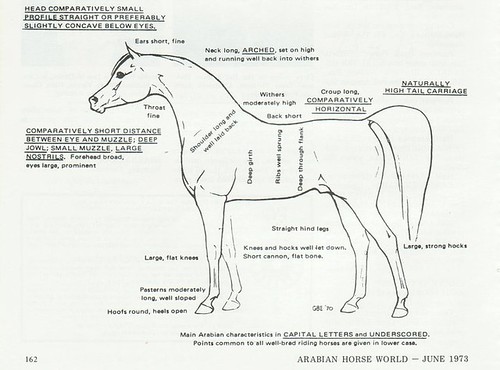The Arabian is a breed of horse that originated on the Arabian Peninsula. With a distinctive head shape and high tail carriage, the Arabian is one of the most easily recognizable horse breeds in the world, says Wikipedia.
It is also one of the oldest breeds, with archaeological evidence of horses that resemble modern Arabians dating back 4,500 years. Throughout history, Arabian horses spread around the world by both war and trade, used to improve other breeds by adding speed, refinement, endurance, and strong bone.
The Arabian developed in a desert climate and was prized by the nomadic Bedouin people, often being brought inside the family tent for shelter and protection from theft. Selective breeding for traits including an ability to form a cooperative relationship with humans created a horse breed that is good-natured, quick to learn, and willing to please. The Arabian also developed the high spirit and alertness needed in a horse used for raiding and war.
Arabian horses have refined, wedge-shaped heads, a broad forehead, large eyes, large nostrils, small muzzles and naturally high tail carriage. Most display a distinctive concave, or "dished" profile.
The proto-Arabian horse may have been domesticated by the people of the Arabian peninsula known today as the Bedouin, some time after they learned to use the camel, approximately 4,000–5,000 years ago.[76][77] Other scholars, noting that horses were common in the Fertile Crescent but rare in the Arabian peninsula prior to the rise of Islam, theorize that the breed as it is known today only developed in large numbers when the conversion of the Persians to Islam in the 7th century brought knowledge of horse breeding and horsemanship to the Bedouin.
The Bedouin way of life depended on camels and horses: Arabians were bred to be war horses with speed, endurance, soundness, and intelligence.[80][81] Because many raids required stealth, mares were preferred over stallions as they were quieter, and therefore would not give away the position of the fighters.[80] A good disposition was also critical; prized war mares were often brought inside family tents to prevent theft and for protection from weather and predators.
skip to main |
skip to sidebar
For students and parents who love education and exploration of the social sciences . . .
Search This Blog
Followers
Blog Archive
-
▼
2013
(99)
-
▼
February
(21)
- Boston to Miami: an Atlantic coast states review
- Social studies issue: America's health in regards ...
- Anime hero artwork competition for NASA
- Comparing the independence struggle of Bedouin peo...
- Abraham and Muhammad were here: the interior of th...
- The language of much of New York and Miami: Yiddish
- Israel: Land of the Bible; Land of Violent Struggle
- Jews in Europe in the Medieval era: Shylock
- Jewish studies: diaspora, separation and prejudices
- Assignment: Comparison report on 2 institutions in...
- Jerusalem: crossroads city holy to three religions
- Arabs vs Turks in WWI and the intervention of TE L...
- Camel, horse and Kaaba
- Life of the Prophet Muhammad, rise of the Islamic ...
- The $10,000 horse: an Arabian
- All about Camelus dromedarius
- Making a point of Cuneiform via a mud tablet and s...
- Indie work: comparison essay on Lawrence of Arabia...
- Review of the Persian Gulf states
- Lawrence / Israel geography Magnet
- Five Pillars of Islam project: 10 pts; due next week
-
▼
February
(21)

